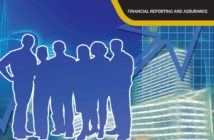By Jim McFie, a Fellow of ICPAK
The ISA for LCEs
Kenya adopted International Standards on Auditing for all audits conducted after 1st January 1999. It also adopted International Accounting Standards, now International Financial Reporting Standards, for all accounting periods starting on or after 1st January 1999: all private sector entities in Kenya have to produce their financial statements in accordance with IFRSs. However, IFRSs started becoming more and more complicated.
The International Accounting Standards Board (IASB) was aware that IFRSs may have become unnecessarily convoluted for smaller entities, and so on 9th July 2009 it promulgated the International Financial Reporting Standard for Small and Medium-sized Entities (the IFRS for SMEs). It was adopted by the Council of the Institute of Certified Public Accountants of Kenya soon after that date: an entity in Kenya can prepare its financial statements in accordance with the IFRS for SMEs, rather than the full IFRSs, and still comply with ICPAK’s requirement. A very important factor in the lives of Kenyans is status – one’s relative social or professional position or standing. Some business owners do not want to use the IFRS for SMEs because they do not want their business to be regarded as SMEs.
The International Finance Corporation (IFC), which is part of the World Bank, defines an SME as a registered business with fewer than 300 employees. Signalhire.com states that Isuzu Kenya Limited employs 123 persons. IndustriALL states that Isuzu employed 228 workers in 2019. Hence, in the eyes of the IFC, Isuzu is an SME. Whatever business owners think about their businesses, they probably are not aware that to prepare a set of financial statements in accordance with IFRSs is considerably more expensive than to prepare those financial statements in accordance with the IFRS for SMEs.
The only restriction on the use of the IFRS for SMEs is that it cannot be used by an entity which has public accountability: an entity has public accountability if its debt or equity instruments are traded in a public market or it is in the process of issuing such instruments for trading in a public market – the Nairobi Securities Exchange – or it holds assets in a fiduciary capacity for a broad group of outsiders as one of its primary businesses: that is, banks, credit unions, Saccos, insurance companies, securities brokers/dealers, mutual funds and investment banks. If an entity holds assets in a fiduciary capacity as an incidental part of its business, that does not make it publicly accountable: public utilities, travel and real estate agents, schools, and charities may use the IFRS for SMEs.
The most profitable segment of the Kenya economy is the banking sector: since the primary business of banks is to hold assets in a fiduciary capacity, banks cannot use the IFRS for SMEs: but the Kenya Bankers Association does produce its financial statements in accordance with the IFRS for SMEs. The Chief Executive Officer, Dr. Habil Olaka, spends KBA’s money wisely. Many entities in Kenya should use the IFRS for SMEs: it is a self-contained Standard of fewer than 250 pages: topics not relevant for SMEs are omitted, for example earnings per share, interim financial reporting and segment reporting; many principles for recognizing and measuring assets, liabilities, income and expenses in the full IFRS Accounting Standards are simplified – for example, amortizing goodwill, recognizing all borrowing and development costs as expenses, using the cost model for associates and jointly-controlled entities; significantly fewer disclosures are required – a 90% reduction; the Standard has been written in clear, easily understood language; and revisions of the IFRS are limited to once every three years.
Under the 2015 Kenya Companies Act, small companies do not need to be audited, unless the members “have required the company to obtain an audit of its financial statements” {Section 709(3)(a)}. Section 711 points out that if a company has turnover in a financial year of not more than fifty million shillings and has net assets in its balance sheet as at the end of that year of not more than twenty million shillings, and satisfies those conditions in the immediately preceding year as well, it is a small company and is exempt from audit. However, KRA requires all companies to submit audited financial statements.
For many years the International Audit and Assurance Standards Board (IAASB) resisted pressure to produce an International Standard on Auditing analogous to the IFRS for SMEs. In the interest of brevity, I shall not go into the factors that forced the hand of the IAASB to follow IASB’s example; the principal factor was the development of a shortened version of the ISAs by the Nordic Accountant Federation in Denmark, Finland, Norway and Sweden. After extensive consultations and an enormous amount of work, in December 2023, the IAASB published the International Standard on Auditing for Audits of Financial Statements of Less Complex Entities, or The ISA for LCEs. It is a 158-pagedocument: the latest IAASB Handbook of International Quality Control, Auditing, Review, Other Assurance, and Related Services Pronouncements is the 2021 edition: volume one is a 902-page tome (a large, heavy, scholarly book), volume two another 348 pages and a supplement of a further 68 pages.
The ISA for LCEs is effective for audits of financial statements of less complex entities for periods beginning on or after 15 December 2025, but early adoption is permitted: I would encourage early adoption. Appendix 7 contains an Illustrative Representation Letter; appendix 6 gives Examples of Factors Influencing Sample Size for Tests of Controls and Test of Details; appendix 5 assertions; appendix 4 Fraud Risk Factors; appendix 3 Identifying and Assessing the Risks of Material Misstatement; appendix 2 an Illustrative Engagement Letter; the format of the Independent Auditor’s Report is on page 103 and is very similar to ISA 700.
The standard contains all the requirements necessary to obtain reasonable assurance about whether the financial statements as a whole are free from material misstatements, whether due to fraud or error. It is easy to understand – it is expressed in plain, simple language and follows the flow of an audit; it contains clear, succinct and concise requirements and guidance, and focuses on matters applicable to LCEs. It cannot be used for the audit of public interest entities, in the same way as the IFRS for SMEs cannot.It can be downloaded from the IAASB free of charge: if you run an audit firm, download it now and start using it immediately for the audits of less complex entities. And save yourself a lot of work and your clients at least a little money.




